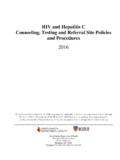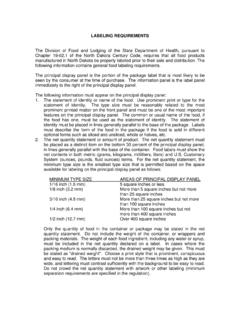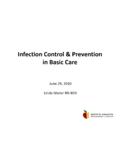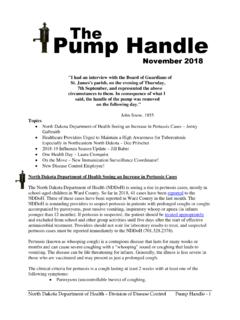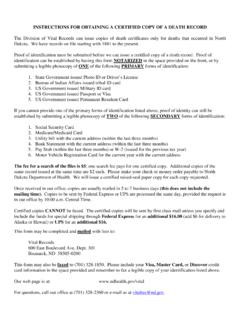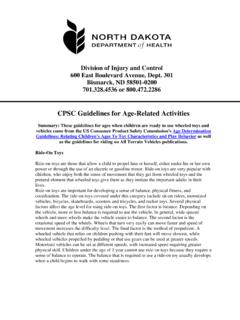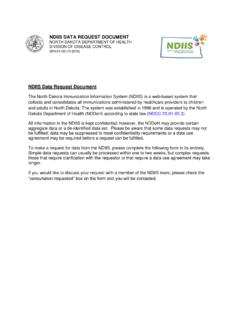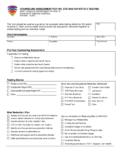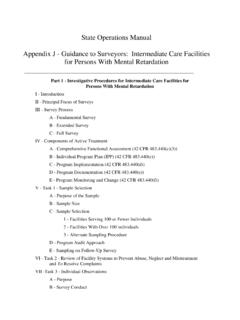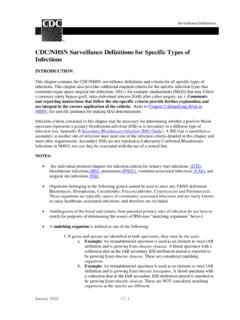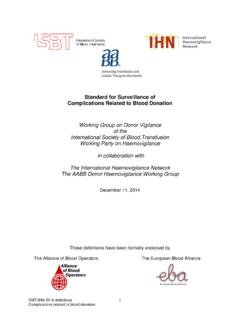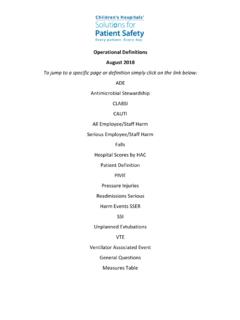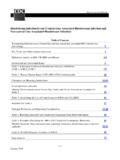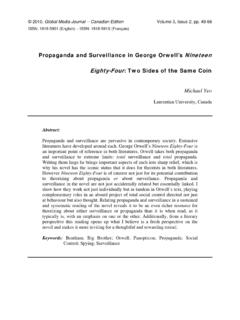Transcription of Surveillance of Infections - North Dakota Department of …
1 Surveillance of InfectionsInfection Prevention ConferenceBismarck, North DakotaAugust 17-18, 2011 Surveillance of Infections Surveillance is an essential component of an effective infection prevention and control program. Sound epidemiological and statistical principles Use Surveillance data to improve the quality of healthcare Challenges Changing healthcare delivery system Emerging and reemerging infectious diseases Mandatory reporting requirementsComponents of a Strong Surveillance Program Should be based on sound epidemiological and statistical principles Designed in accordance with current recommended practices Needs to be able to identify risk factors for infection Adverse events Implement risk-reduction measures Monitor the effectiveness of intervention Identify Outbreaks
2 Emerging infectious diseases Antibiotic-resistant organisms Bioterrorist events Components of a Strong Surveillance Program Include Infection prevention Performance improvement Patient safety Public health activities Mandatory and public reporting requirements Surveillance data Reduce the occurrence of Infections by using risk factors and implementation of risk-reduction measures and monitoring effectiveness of Definition Ongoing collection, collation, and analysis of data and the ongoing dissemination of information to those who need to know so that action can be taken.
3 Reference: Last JM, ed. A Dictionary of Epidemiology. 4thed. New York: Oxford University Press; 2001:174 Surveillance is an essential component of an effective infection prevention program. First recommended for hospitals by the American Hospital Association in 1958 Staphylococcus aureus 1960 CDC 1976 Joint CommissionSENIC PROJECT 1985 Study on the Efficacy of Nosocomial Infection Control Scientific evidence that hospitals with strong Surveillance programs strong prevention and control programs improved patient outcomes by reducing HAI Since 1985 healthcare delivery systems has shifted outside of the acute care hospital Publication of Surveillance recommendations for outpatient settings Hospitals, LTC, rehab, ASC, dialysis, home care, hospice.
4 Mental health, and correctional facilitiesFactors Affecting Surveillance Programs Shorter hospital stays Aging of the population Increased use of invasive procedures and devices More acutely ill patients and residents Healthcare worker shortage Emerging and reemerging infectious diseases Threat of bioterrorism Mandatory and public reporting New diseases emerging Antimicrobial resistance Mandatory reporting requirements increase New Surveillance methods are needed to meet the changing environmentPurpose of Surveillance Determine baseline and endemic rates of
5 Occurrence of a disease or event Detect and investigate clusters or outbreaks Assess the effectiveness of prevention and control measures Monitor the occurrence of adverse outcomes to identify potential risk factors Provide information that can be used by an organization to target performance improvement activities Measure the efficacy of interventional and performance improvement efforts Observe practices, such as hand hygiene and sterilizer performance monitoring, to promote compliance with recommendations and standards Detect and report notifiable diseases to the health Department Identify organisms and diseases of epidemiological importance, such as AROs and tuberculosis, to prevent their spread Ensure compliance with requirements of federal regulators, such as the Occupational Safety and Health Administration and the Centers for Medicare and Medicaid ServicesPurpose of Surveillance Ensure compliance with state regulations and state mandatory reporting requirement Meet requirements of accrediting agencies.
6 Such as the Joint Commission and the Commission on Accreditation of Rehabilitation Facilities (CARF) Provide information for the education of healthcare personnel Monitor injuries and identify risk factors for injuries in personnel Detect a bioterrorist event or an emerging infectious disease Provide data to conduct a facility risk assessment for diseases, such as legionellosis or tuberculosisTypes of Surveillance Total or Whole House Surveillance Monitors all HAI in the entire facility Overall facility infection rate should not be calculated Rates should be calculated for specific AHIs in a defined population Example.
7 Central line-associated bloodstream Infections in an ICU Surgical site infection for a particular surgery such as hips, knee, CABGs Overall facility rates are not sensitive enough to identify potential problems Are not adjusted for specific infection or injury risks so they are not appropriate for: measuring trends over time Comparisons between groups Benchmarking Although ideal most facilities do not have the technical and personnel resources to do house-wide Surveillance Target Surveillance is generally conductedTypes of Surveillance Target Surveillance 1990 CDC shifted from total house Surveillance to target Surveillance (NNIS system) Focuses on.
8 Particular care units ( , ICU, nurseries etc) Infections related to devices ( , intravascular and urinary catheters) Invasive procedures ( , surgery) Organisms ( , resistant organisms such as MRSA, VRE, ESBL, etc) Focuses on high-risk, high-volume procedures and adverse outcomes that are potentially preventable Infection Definitions Acute Definitions for LTC Infection Definitions for LTC Infections There is a CDC/SHEA project to revise infection Surveillance definitions for LTC in progress. The plan is for these definitions to be available by early Fall. NHSN is releasing a newly designed LTCF component in October 2011 which will enable SNF/NHs to enroll in the system and perform reporting on UTI events, MDRO/CDI lab-ID events.
9 And prevention process measures (hand hygiene/gown and glove use). These will be the only reporting options available when it is released. Home Care and Hospice Infection Infection Definitions Behavioral Health, Correctional Facilities, Drug Treatment Facilities, Rehab, LTACs No national definitions yet. Take other definitions and fit them to these settings LTACs may consider using acute care definition Behavioral Health definitions are currently being developedNumerator/Denominator Numerator: the upper portion of a fraction used to calculate a rate or ratio. In Surveillance , it is usually the number of cases of a disease or event being studied.
10 Denominator: the lower portion of a fraction used to calculate a rate or :5 UTIs/135 Catheter Days = rate5 is the Numerator135 is the DenominatorDenominator can be: census (rarely used), patient or resident days, device days, number of visits, number of surgical site cases (by type of surgery)Infection Rate CalculationExample of rate calculation:In June, there were three catheter-associated primary bloodstream Infections (CABSIs) and 491 central line days in an number of BSIs in ICU patients in June/number of central line days in ICU patients in June X 10003/491 x 1000 = rate is interpreted as CABSIs per 1000 central line-days in the ICU in Rate CalculationExample:In August there were two resident wound Infections in a LTC unit that had 275 residents days.
